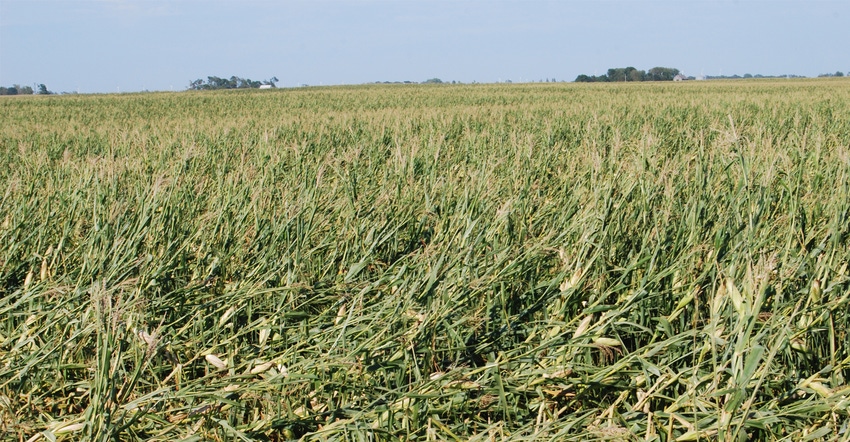August 28, 2020

Drought, wind and heat have reduced the size of Iowa crops from their Aug. 1 lofty levels. However, much of the Corn Belt is expected to have above-average crop yields that will make up for Iowa’s production shortfall. Pricing both old-and new-crop bushels will continue to add stress and anxiety to an already challenging crop year.
USDA’s August crop production report, released Aug. 12, projected a national average corn yield of 181.1 bushels per acre and soybeans at 53.3 bushels per acre. Iowa’s corn crop was expected to average 202 bushels per acre and soybeans at 58 bushels per acre. Those projections assumed normal weather going forward from Aug. 1, which hasn’t occurred.
Estimated crop damage
Iowa likely won’t have a solid idea on the size of this year’s corn and soybean crops until the combines roll. Early estimates of crop damage from the Aug. 10 windstorm indicated 57 counties in the state were in the path of the derecho. USDA’s Risk Management Agency several days after the storm estimated 8.2 million acres of corn and 5.6 million acres of soybeans in those counties may have been impacted by the storm.
On Aug. 18, based on satellite imagery and U.S. Storm Prediction Center preliminary storm reports, the Iowa Department of Agriculture issued an updated estimate of 36 counties in Iowa hit hardest by the Aug. 10 storm. Within those 36 counties, the storm likely had the greatest impact on 3.57 million acres of corn and 2.5 million acres of soybeans. That represents about 25% of Iowa’s planted acres of corn and soybeans in 2020.
This 6 million-acre estimate of corn and soybeans being hit hardest in Iowa is about 3.5% of the total corn and soybean acres planted in the U.S. this year. The early loss estimate due to wind was 150 million bushels of corn. However, the heat and lack of moisture is also taking its toll on already stressed crops.
The crop damage looks extreme, but corn plants have an ability to hang onto ears. If the ears can enter the combine instead of being left in the field, Iowa’s corn crop could end up not being reduced as much as some people think.
Quality of the grain harvested and whether storage space is adequate for crops this fall are also factors that will affect corn and soybean prices. Tens of millions of bushels of on-farm storage space was lost in central and east-central Iowa as bins were damaged or destroyed. Several co-ops were damaged by the derecho. Early estimates indicate more than 57 million bushels of permanently licensed grain storage was seriously damaged or destroyed. The co-ops report it will cost more than $300 million to remove, replace or repair their damaged grain bins.
Storage space to run short
You can expect challenges with storage space running short this fall due to the number of damaged bins, both on-farm and commercially. The August wind damage could lead to much weaker basis prices at some commercial storage facilities and for corn stored outside in bunkers. However, strengthening of the basis could result at processing facilities where local supplies of corn and soybeans could be limited. Also, corn quality issues will likely emerge from both drought and wind-damaged corn.
For unpriced corn bushels with quality concerns, consider feeding or moving as much of this grain as possible this fall. This grain will prove difficult to store. Futures prices have rallied due to lower estimated production numbers in anticipation of lower production estimates in USDA’s Sept. 11 report. Meanwhile, Chinese Phase 1 grain purchases have remained steady this summer, and dry conditions in Brazil will likely slow early planting of the country’s soybeans.
On Aug. 10, USDA increased both corn and soybean ending stocks for this next marketing year and lowered projected cash prices to $3.10 per bushel for corn and $8.35 per bushel for soybeans. If you think futures prices will continue to rally this fall and winter, consider selling cash corn and reownership using a basis or minimum-price contract for the March contract. For soybeans, take advantage of both higher futures prices and a stronger basis to generate cash flow needs.
Johnson is an ISU Extension farm management specialist. Email [email protected].
About the Author(s)
You May Also Like






